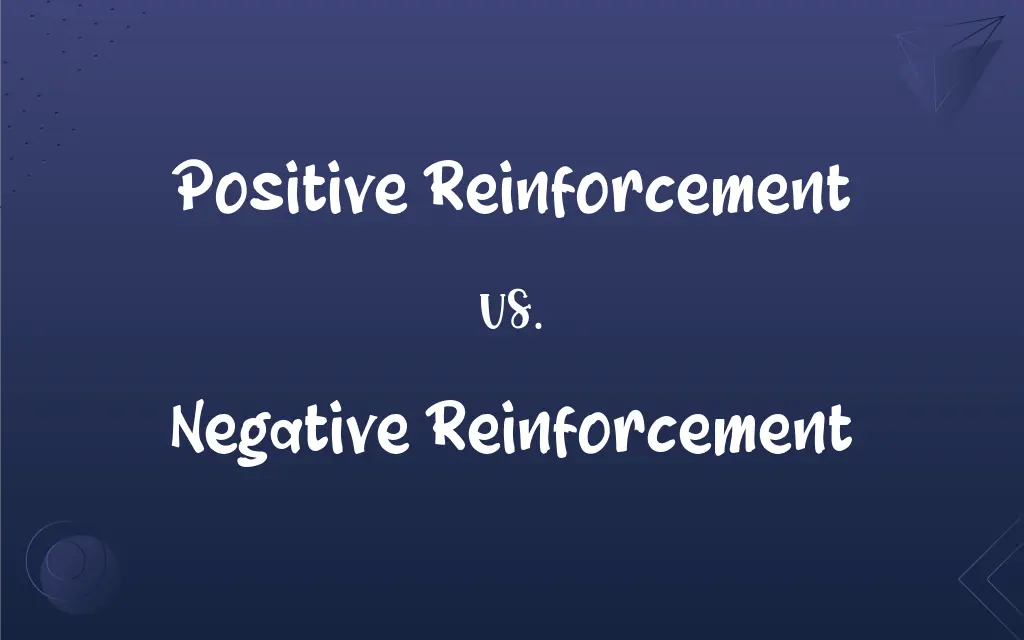Positive Reinforcement vs. Negative Reinforcement: What's the Difference?
Edited by Aimie Carlson || By Janet White || Published on February 26, 2024
Positive reinforcement involves adding a pleasant stimulus to increase a behavior, while negative reinforcement involves removing an unpleasant stimulus to increase a behavior.

Key Differences
Positive reinforcement occurs when a favorable outcome, event, or reward is presented after a behavior, making that behavior more likely to happen again. In contrast, negative reinforcement involves the removal, prevention, or decrease of an unfavorable outcome or event, which also increases the likelihood of a behavior being repeated.
With positive reinforcement, an individual receives something they desire following their behavior, such as praise or a reward. Negative reinforcement, however, typically involves the removal of an unpleasant condition, like taking painkillers to remove pain, which encourages the behavior (taking medication) to recur.
Positive reinforcement is often seen in educational and work settings as rewards or compliments for good performance, which encourages continuation of the behavior. On the other hand, negative reinforcement might be used when a negative condition is removed once a desired behavior is displayed, such as turning off a loud alarm when a task is completed.
In positive reinforcement, the focus is on adding something desirable to reinforce a behavior, like giving a child a treat for doing homework. In negative reinforcement, the focus is on removing or avoiding a negative condition, such as exempting a student from a disliked task after they demonstrate improvement in a subject.
The key similarity between both is that they are used to increase the likelihood of a behavior being repeated, but they differ in their methods; positive reinforcement adds a pleasant stimulus, while negative reinforcement takes away an unpleasant one.
ADVERTISEMENT
Comparison Chart
Stimulus Type
Addition of a pleasant stimulus
Removal of an unpleasant stimulus
Example in Education
Giving a student a sticker for a correct answer
Removing a difficult assignment for improved behavior
Example in Workplace
Bonus for achieving targets
Reducing workload for meeting deadlines
Psychological Impact
Encourages by rewarding
Encourages by relieving or preventing discomfort
Outcome on Behavior
Makes desirable behavior more likely to be repeated
Makes desirable behavior more likely to be repeated
ADVERTISEMENT
Positive Reinforcement and Negative Reinforcement Definitions
Positive Reinforcement
Encouraging behavior by offering rewards.
Positive reinforcement was used by giving a bonus for high sales.
Negative Reinforcement
Strengthening behavior by removing adverse consequences.
The therapist used negative reinforcement, easing restrictions as progress was made.
Positive Reinforcement
Introducing a pleasant outcome to reinforce an action.
They used positive reinforcement, praising the dog for following commands.
Negative Reinforcement
Removing an unpleasant stimulus to encourage behavior.
Negative reinforcement was used by canceling the quiz for improved class attendance.
Positive Reinforcement
Adding a rewarding stimulus after a behavior.
The teacher gave extra playtime as positive reinforcement for good classroom behavior.
Negative Reinforcement
Reinforcing actions by alleviating negative conditions.
She used negative reinforcement, stopping the nagging once chores were done.
Positive Reinforcement
Strengthening behavior through positive consequences.
The coach used positive reinforcement, commending players for their effort.
Negative Reinforcement
Motivating through the relief of undesirable outcomes.
Reducing the workload was negative reinforcement for timely project completion.
Positive Reinforcement
Incentivizing desired actions with benefits.
Offering a discount was a form of positive reinforcement for loyal customers.
Negative Reinforcement
Encouraging behavior by taking away discomfort.
Turning off a loud noise to encourage correct responses is negative reinforcement.
FAQs
What is positive reinforcement?
Positive reinforcement involves adding a pleasant stimulus to increase a desired behavior.
What is negative reinforcement?
Negative reinforcement involves removing an unpleasant stimulus to increase a behavior.
What are examples of positive reinforcement in the workplace?
Examples include bonuses, recognition awards, and verbal praise for good performance.
Is negative reinforcement the same as punishment?
No, negative reinforcement increases a behavior by removing negatives, while punishment decreases behavior.
Can positive reinforcement be used in parenting?
Yes, it's often used in parenting by rewarding children for good behavior.
Can negative reinforcement be used to stop bad habits?
Yes, by removing a negative stimulus when the undesirable behavior is avoided.
How does negative reinforcement work in education?
It can involve removing unpleasant tasks or conditions when students exhibit desired behavior.
How quickly should positive reinforcement be given after the desired behavior?
It should be given soon after the behavior to effectively associate the two.
What's a common misconception about negative reinforcement?
A common misconception is that it involves adding a negative consequence, but it's about removing a negative.
Does negative reinforcement always work?
Its effectiveness depends on the individual's perception of what is unpleasant and the context.
Should positive reinforcement be consistent?
Consistency in positive reinforcement helps in establishing and maintaining desired behaviors.
Is negative reinforcement ethical?
It's ethical if used responsibly and without causing harm or undue stress.
Are rewards always effective in positive reinforcement?
Rewards are effective if they are desirable to the recipient and appropriately timed.
Can negative reinforcement lead to dependency on the removal of the negative stimulus?
Yes, if overused, it can lead to reliance on the removal of the unpleasant condition.
Is positive reinforcement always positive?
It's considered positive in terms of adding a pleasant stimulus, but its effectiveness depends on the context.
What are long-term effects of positive reinforcement?
Long-term effects can include sustained behavioral change and increased motivation.
What role does timing play in positive reinforcement?
Timely reinforcement is crucial for establishing a clear connection between behavior and reward.
How can positive reinforcement be misused?
Misuse occurs when it inadvertently reinforces undesirable behaviors or creates dependency.
Can negative reinforcement be used in animal training?
Yes, like removing a tight leash when a dog walks correctly.
Does negative reinforcement work in all types of behaviors?
Its effectiveness can vary based on the behavior and individual differences.
About Author
Written by
Janet WhiteJanet White has been an esteemed writer and blogger for Difference Wiki. Holding a Master's degree in Science and Medical Journalism from the prestigious Boston University, she has consistently demonstrated her expertise and passion for her field. When she's not immersed in her work, Janet relishes her time exercising, delving into a good book, and cherishing moments with friends and family.
Edited by
Aimie CarlsonAimie Carlson, holding a master's degree in English literature, is a fervent English language enthusiast. She lends her writing talents to Difference Wiki, a prominent website that specializes in comparisons, offering readers insightful analyses that both captivate and inform.































































